Enhanced Amazon Wetland Map with Multi-Source Remote Sensing Data
Highlights
- A novel method using multi-source remote sensing, expert knowledge, and machine learning accurately revealed 151.7 Mha of wetlands in the Amazon region in 2020.
- This study offers a detailed analysis of the protection status of the Amazon wetlands, quantifies the pressures and threats posed by land use and climate change, and provides a baseline for monitoring.
- The Amazon region wetland map can effectively guide national inventories and support science-based decision-making by governments and local communities.
- Expanding protection by creating new Ramsar Sites and conservation areas within the 72 Mha of unprotected wetlands presents a pivotal opportunity.
Abstract
1. Introduction
2. Materials and Methods
2.1. Study Area
2.2. Wetland Maps and Classes
2.3. Wetland Classification
2.4. Wetland Protection and Impacts
3. Results
3.1. Wetland Mapping
3.2. Protected Wetlands
3.3. Wetland Threats and Pressures
3.3.1. Land Use
3.3.2. Infrastructure
3.3.3. Climate Change
4. Discussion
4.1. Challenges of Mapping Wetlands
4.2. The Loss of Wetland Habitats
4.3. Opportunities for Conservation and Management of Wetlands
5. Conclusions
Supplementary Materials
Author Contributions
Funding
Data Availability Statement
Acknowledgments
Conflicts of Interest
References
- Goulding, M.; Venticinque, E.; Ribeiro, M.L.d.B.; Barthem, R.B.; Leite, R.G.; Forsberg, B.; Petry, P.; Lopes da Silva-Júnior, U.; Ferraz, P.S.; Cañas, C. Ecosystem-Based Management of Amazon Fisheries and Wetlands. Fish Fish. 2019, 20, 138–158. [Google Scholar] [CrossRef]
- Junk, W.J.; Soares, M.G.M.; Bayley, P.B. Freshwater Fishes of the Amazon River Basin: Their Biodiversity, Fisheries, and Habitats. Aquat. Ecosyst. Health Manag. 2007, 10, 153–173. [Google Scholar] [CrossRef]
- Jézéquel, C.; Tedesco, P.A.; Bigorne, R.; Maldonado-Ocampo, J.A.; Ortega, H.; Hidalgo, M.; Martens, K.; Torrente-Vilara, G.; Zuanon, J.; Acosta, A.; et al. A Database of Freshwater Fish Species of the Amazon Basin. Sci. Data 2020, 7, 96. [Google Scholar] [CrossRef]
- Myers, J.P. Conservation of Migrating Shorebirds: Staging Areas, Geographic Bottlenecks, and Regional Movements. Am. Birds 1983, 37, 5. [Google Scholar]
- Junk, W.J.; Brown, M.; Campbell, I.C.; Finlayson, M.; Gopal, B.; Ramberg, L.; Warner, B.G. The Comparative Biodiversity of Seven Globally Important Wetlands: A Synthesis. Aquat. Sci. 2006, 68, 400–414. [Google Scholar] [CrossRef]
- Castello, L.; Mcgrath, D.G.; Hess, L.L.; Coe, M.T.; Lefebvre, P.A.; Petry, P.; Macedo, M.N.; Renó, V.F.; Arantes, C.C. The Vulnerability of Amazon Freshwater Ecosystems. Conserv. Lett. 2013, 6, 217–229. [Google Scholar] [CrossRef]
- Flores, B.M.; Holmgren, M.; Xu, C.; Van Nes, E.H.; Jakovac, C.C.; Mesquita, R.C.G.; Scheffer, M. Floodplains as an Achilles’ Heel of Amazonian Forest Resilience. Proc. Natl. Acad. Sci. USA 2017, 114, 4442–4446. [Google Scholar] [CrossRef]
- Castello, L.; Macedo, M.N. Large-Scale Degradation of Amazonian Freshwater Ecosystems. Glob. Change Biol. 2016, 22, 990–1007. [Google Scholar] [CrossRef] [PubMed]
- Ameli, A.; Creed, I.F. Does Wetland Location Matter When Managing Wetlands for Watershed-Scale Flood and Drought Resilience? Jawra J. Am. Water Resour. Assoc. 2019, 55, 529–542. [Google Scholar] [CrossRef]
- Gumbricht, T.; Roman-Cuesta, R.M.; Verchot, L.; Herold, M.; Wittmann, F.; Householder, E.; Herold, N.; Murdiyarso, D. An Expert System Model for Mapping Tropical Wetlands and Peatlands Reveals South America as the Largest Contributor. Glob. Change Biol. 2017, 23, 3581–3599. [Google Scholar] [CrossRef]
- Lowry, J.; Hess, L.; Rosenqvist, A. Mapping and Monitoring Wetlands Around the World Using ALOS PALSAR: The ALOS Kyoto and Carbon Initiative Wetlands Products; Springer: Berlin/Heidelberg, Germany, 2009; pp. 105–120. [Google Scholar]
- Tootchi, A.; Jost, A.; Ducharne, A. Multi-Source Global Wetland Maps Combining Surface Water Imagery and Groundwater Constraints. Earth Syst. Sci. Data 2019, 11, 189–220. [Google Scholar] [CrossRef]
- Junk, W.J.; Piedade, M.T.F. The Amazon River basin. In The World’s Largest Wetlands: Ecology and Conservation; Fraser, L.H., Keddy, P.A., Eds.; Cambridge University Press: Cambridge, UK, 2005; pp. 63–117. [Google Scholar]
- Yi, Q.; Huixin, G.; Yaomin, Z.; Jinlian, S.; Xingyu, Z.; Huize, Y.; Jiaxin, W.; Zhenguo, N.; Liping, L.; Shudong, W.; et al. Global Conservation Priorities for Wetlands and Setting Post-2025 Targets. Commun. Earth Environ. 2024, 5, 1–11. [Google Scholar] [CrossRef]
- Fluet-Chouinard, E.; Stocker, B.D.; Zhang, Z.; Malhotra, A.; Melton, J.R.; Poulter, B.; Kaplan, J.O.; Goldewijk, K.K.; Siebert, S.; Minayeva, T.; et al. Extensive Global Wetland Loss over the Past Three Centuries. Nature 2023, 614, 281–286. [Google Scholar] [CrossRef]
- Hu, S.; Niu, Z.; Chen, Y.; Li, L.; Zhang, H. Global Wetlands: Potential Distribution, Wetland Loss, and Status. Sci. Total Environ. 2017, 586, 319–327. [Google Scholar] [CrossRef] [PubMed]
- Darrah, S.E.; Shennan-Farpón, Y.; Loh, J.; Davidson, N.C.; Finlayson, C.M.; Gardner, R.C.; Walpole, M.J. Improvements to the Wetland Extent Trends (WET) Index as a Tool for Monitoring Natural and Human-Made Wetlands. Ecol. Indic. 2019, 99, 294–298. [Google Scholar] [CrossRef]
- Scott, D.A.; Jones, T.A. Classification and Inventory of Wetlands: A Global Overview. Vegetatio 1995, 118, 3–16. [Google Scholar] [CrossRef]
- Junk, W.J.; Piedade, M.T.F.; Schöngart, J.; Cohn-Haft, M.; Adeney, J.M.; Wittmann, F. A Classification of Major Naturally-Occurring Amazonian Wetlands. Wetlands 2011, 31, 623–640. [Google Scholar] [CrossRef]
- Junk, W.J.; Piedade, M.T.F.; Lourival, R.; Wittmann, F.; Kandus, P.; Lacerda, L.D.; Bozelli, R.L.; Esteves, F.A.; Nunes da Cunha, C.; Maltchik, L.; et al. Brazilian Wetlands: Their Definition, Delineation, and Classification for Research, Sustainable Management, and Protection. Aquat. Conserv. 2014, 24, 5–22. [Google Scholar] [CrossRef]
- Davidson, N.C.; Finlayson, C.M. Extent, Regional Distribution and Changes in Area of Different Classes of Wetland. Mar. Freshw. Res. 2018, 69, 1525–1533. [Google Scholar] [CrossRef]
- WETLANDS|AMAZON WATERS ALLIANCE. Available online: https://en.aguasamazonicas.org/wetlands (accessed on 26 March 2024).
- Haggar, K.M. Defining Wetlands. Soc. Wetl. Sci. Bull. 2001, 18, 5–10. [Google Scholar] [CrossRef]
- Mahdianpari, M.; Granger, J.; Mohammadimanesh, F.; Salehi, B.; Brisco, B.; Homayouni, S.; Gill, E.W.; Huberty, B.; Lang, M. Meta-Analysis of Wetland Classification Using Remote Sensing: A Systematic Review of a 40-Year Trend in North America. Remote Sens. 2020, 12, 1882. [Google Scholar] [CrossRef]
- Gallant, A.L. The Challenges of Remote Monitoring of Wetlands. Remote Sens. 2015, 7, 10938–10950. [Google Scholar] [CrossRef]
- Fleischmann, A.S.; Papa, F.; Fassoni-Andrade, A.C.; Mélack, J.M.; Wongchuig, S.; Paiva, R.C.D.d.; Hamilton, S.K.; Fluet-Chouinard, E.; Barbedo, R.; Aires, F.; et al. How Much Inundation Occurs in the Amazon River Basin? Remote Sens. Environ. 2022, 278, 113099. [Google Scholar] [CrossRef]
- Amani, M.; Brisco, B.; Afshar, M.; Mirmazloumi, S.M.; Mahdavi, S.; Mirzadeh, S.M.J.; Huang, W.; Granger, J. A Generalized Supervised Classification Scheme to Produce Provincial Wetland Inventory Maps: An Application of Google Earth Engine for Big Geo Data Processing. Big Earth Data 2019, 3, 378–394. [Google Scholar] [CrossRef]
- Souza, C.M.; Kirchhoff, F.T.; Oliveira, B.C.; Ribeiro, J.G.; Sales, M.H. Long-Term Annual Surface Water Change in the Brazilian Amazon Biome: Potential Links with Deforestation, Infrastructure Development and Climate Change. Water 2019, 11, 566. [Google Scholar] [CrossRef]
- Wang, X.; Ling, F.; Yao, H.; Liu, Y.; Xu, S. Unsupervised Sub-Pixel Water Body Mapping with Sentinel-3 OLCI Image. Remote Sens. 2019, 11, 327. [Google Scholar] [CrossRef]
- Yan, X.; Niu, Z. Reliability Evaluation and Migration of Wetland Samples. IEEE J. Sel. Top. Appl. Earth Obs. Remote Sens. 2021, 14, 8089–8099. [Google Scholar] [CrossRef]
- Chaudhary, R.K.; Puri, L.; Acharya, A.K.; Aryal, R.R. Wetland Mapping and Monitoring with Sentinel-1 and Sentinel-2 Data on the Google Earth Engine. J. For. Nat. Resour. Manag. 2023, 3, 1–21. [Google Scholar] [CrossRef]
- Eva, H.; Huber, O.; Achard, F.; Balslev, H.; Beck, S.; Behling, H.; Belward, A.; Beuchle, R.; Cleef, A.; Colchester, M.; et al. (Eds.) A Proposal for Defining the Geographical Boundaries of Amazonia; EUR 21808 EN; JRC68635; Office for Official Publications of the European Communities: Luxembourg, 2005; ISBN 92-79-00012-8. [Google Scholar]
- Infographic—RAISG. Available online: https://www.raisg.org/en/infographic/ (accessed on 26 March 2024).
- Brañas, M.; Fabiano, E.; Schulz, C.; Martín Brañas, M. Scotland’s Rural College Wetland Spirits and Indigenous Knowledge: Implications for the Conservation of Wetlands in the Peruvian Amazon Wetland Spirits and Indigenous Knowledge: Implications for the Conservation of Wetlands in the Peruvian Amazon. Curr. Res. Environ. Sustain. 2021, 3, 100107. [Google Scholar] [CrossRef]
- Legal Amazon|IBGE. Available online: https://www.ibge.gov.br/en/geosciences/maps/regional-maps/17927-legal-amazon.html?edicao=18047 (accessed on 26 March 2024).
- Bunting, P.; Rosenqvist, Å.; Hilarides, L.; Lucas, R.; Thomas, N.; Tadono, T.; Worthington, T.A.; Spalding, M.; Murray, N.; Rebelo, L. Global Mangrove Extent Change 1996–2020: Global Mangrove Watch Version 3.0. Remote Sens. 2022, 14, 3657. [Google Scholar] [CrossRef]
- Zanaga, D.; Van De Kerchove, R.; Daems, D.; De Keersmaecker, W.; Brockmann, C.; Kirches, G.; Wevers, J.; Cartus, O.; Santoro, M.; Fritz, S.; et al. ESA WorldCover 10 m 2021 V200. Zenodo 2021. [Google Scholar] [CrossRef]
- Mazur, E.; Sims, M.; Goldman, E.; Schneider, M.; Daldoss Pirri, M.; Beatty, C.R.; Stolle, F.; Stevenson, M. SBTN Natural Lands Map-Technical Documentation. 2024. Available online: https://sciencebasedtargetsnetwork.org/wp-content/uploads/2024/09/Technical-Guidance-2024-Step3-Land-v1-Natural-Lands-Map.pdf#page=7.10 (accessed on 22 July 2025).
- Zhang, X.; Liu, L.; Zhao, T.; Chen, X.; Lin, S.; Wang, J.; Jun, M.; Liu, W. GWL_FCS30: A Global 30 m Wetland Map with a Fine Classification System Using Multi-Sourced and Time-Series Remote Sensing Imagery in 2020. Earth Syst. Sci. Data 2023, 15, 265–293. [Google Scholar] [CrossRef]
- Murray, N.J.; Phinn, S.P.; Fuller, R.A.; DeWitt, M.; Ferrari, R.; Johnston, R.; Clinton, N.; Lyons, M.B. High-Resolution Global Maps of Tidal Flat Ecosystems from 1984 to 2019. Sci. Data 2022, 9, 542. [Google Scholar] [CrossRef]
- Worthington, T.A.; Spalding, M.; Landis, E.; Maxwell, T.L.; Navarro, A.; Smart, L.S.; Murray, N.J. The Distribution of Global Tidal Marshes from Earth Observation Data. Glob. Ecol. Biogeogr. 2024, 33, e13852. [Google Scholar] [CrossRef]
- Souza, C.M.; Marengo, J.; Ferreira, B.; Ribeiro, J.; Schirmbeck, L.W.; Schirmbeck, J.; Hirye, M.; Cunha, A.; Wiederhecker, H.C.; Latuf, M.O. Amazon Severe Drought in 2023 Triggered Surface Water Loss. Environ. Res. Clim. 2024, 3, 041002. [Google Scholar] [CrossRef]
- Pekel, J.F.; Cottam, A.; Gorelick, N.; Belward, A.S. High-Resolution Mapping of Global Surface Water and Its Long-Term Changes. Nature 2016, 540, 418–422. [Google Scholar] [CrossRef]
- Hess, L.L.; Melack, J.M.; Affonso, A.G.; Barbosa, C.; Gastil-Buhl, M.; Novo, E.M.L.M. Wetlands of the Lowland Amazon Basin: Extent, Vegetative Cover, and Dual-Season Inundated Area as Mapped with JERS-1 Synthetic Aperture Radar. Wetlands 2015, 35, 745–756. [Google Scholar] [CrossRef]
- Potapov, P.; Hansen, M.C.; Pickens, A.; Hernandez-Serna, A.; Tyukavina, A.; Turubanova, S.; Zalles, V.; Li, X.; Khan, A.; Stolle, F.; et al. The Global 2000–2020 Land Cover and Land Use Change Dataset Derived from the Landsat Archive: First Results. Front. Remote Sens. 2022, 3, 18. [Google Scholar] [CrossRef]
- Yury, E.; Cayo, T.; Borja, M.O.; Espinoza-Villar, R.; Moreno, N.; Camargo, R.; Almeida, C.; Hopfgartner, K.; Yarleque, C.; Souza, C.M. Mapping Three Decades of Changes in the Tropical Andean Glaciers Using Landsat Data Processed in the Earth Engine. Remote Sens. 2022, 14, 1974. [Google Scholar] [CrossRef]
- Tan, K.; Sun, D.; Dou, W.; Wang, B.; Sun, Q.; Liu, X.; Zhang, H.; Yang, L.; Lun, F. Mapping Coastal Wetlands and Their Dynamics in the Yellow River Delta over Last Three Decades: Based on a Spectral Endmember Space. Remote Sens. 2023, 15, 5003. [Google Scholar] [CrossRef]
- Shimada, M.; Itoh, T.; Motooka, T.; Watanabe, M.; Shiraishi, T.; Thapa, R.; Lucas, R. New Global Forest/Non-Forest Maps from ALOS PALSAR Data (2007–2010). Remote Sens. Env. 2014, 155, 13–31. [Google Scholar] [CrossRef]
- Adeli, S.; Salehi, B.; Mahdianpari, M.; Quackenbush, L.J.; Brisco, B.; Tamiminia, H.; Shaw, S.B. Wetland Monitoring Using SAR Data: A Meta-Analysis and Comprehensive Review. Remote Sens. 2020, 12, 2190. [Google Scholar] [CrossRef]
- FABDEM (Forest and Buildings Removed Copernicus 30m DEM)—Awesome-Gee-Community-Catalog. Available online: https://gee-community-catalog.org/projects/fabdem/#citation (accessed on 31 March 2025).
- Beven, K.J.; Kirkby, M.J. A Physically Based, Variable Contributing Area Model of Basin Hydrology/Un Modèle à Base Physique de Zone d’appel Variable de l’hydrologie Du Bassin Versant. Hydrol. Sci. J. 1979, 24, 43–69. [Google Scholar] [CrossRef]
- Lang, N.; Jetz, W.; Schindler, K.; Wegner, J.D. A High-Resolution Canopy Height Model of the Earth. Nat. Ecol. Evol. 2023, 7, 1778–1789. [Google Scholar] [CrossRef]
- Du, L.; McCarty, G.W.; Zhang, X.; Lang, M.; Vanderhoof, M.K.; Li, X.; Huang, C.; Lee, S.; Zou, Z. Mapping Forested Wetland Inundation in the Delmarva Peninsula, USA Using Deep Convolutional Neural Networks. Remote Sens. 2020, 12, 644. [Google Scholar] [CrossRef]
- Souza, C.M., Jr.; Roberts, D.A.; Cochrane, M.A. Combining Spectral and Spatial Information to Map Canopy Damage from Selective Logging and Forest Fires. Remote Sens. Environ. 2005, 98, 329–343. [Google Scholar] [CrossRef]
- Rennó, C.D.; Nobre, A.D.; Cuartas, L.A.; Soares, J.V.; Hodnett, M.G.; Tomasella, J.; Waterloo, M.J. HAND, a New Terrain Descriptor Using SRTM-DEM: Mapping Terra-Firme Rainforest Environments in Amazonia. Remote Sens. Environ. 2008, 112, 3469–3481. [Google Scholar] [CrossRef]
- Olofsson, P.; Foody, G.M.; Herold, M.; Stehman, S.V.; Woodcock, C.E.; Wulder, M.A. Good Practices for Estimating Area and Assessing Accuracy of Land Change. Remote Sens. Environ. 2014, 148, 42–57. [Google Scholar] [CrossRef]
- Funk, C.; Peterson, P.; Landsfeld, M.; Pedreros, D.; Verdin, J.; Shukla, S.; Husak, G.; Rowland, J.; Harrison, L.; Hoell, A.; et al. The Climate Hazards Infrared Precipitation with Stations—A New Environmental Record for Monitoring Extremes. Sci. Data 2015, 2, 150066. [Google Scholar] [CrossRef]
- Kingsford, R.T.; Bino, G.; Finlayson, C.M.; Falster, D.S.; Fitzsimons, J.; De, G.; Murray, N.J.; Grillas, P.; Gardner, R.H.; Regan, T.J.; et al. Ramsar Wetlands of International Importance–Improving Conservation Outcomes. Front. Environ. Sci. 2021, 9, 643367. [Google Scholar] [CrossRef]
- Adeleye, M.A.; Haberle, S.; Harris, S.; Connor, S.; Stevenson, J. Assessing Long-Term Ecological Changes in Wetlands of the Bass Strait Islands, Southeast Australia: Palaeoecological Insights and Management Implications. Wetlands 2021, 41, 88. [Google Scholar] [CrossRef]
- Sarkar, P.; Salami, M.F.; Githiora, Y.; Vieira, R.R.S.; Navarro, A.; Clavijo, D.; Padgurschi, M.C.G. A Conceptual Model to Understand the Drivers of Change in Tropical Wetlands: A Comparative Assessment in India and Brazil. Biota Neotrop. 2020, 20 (Suppl. S1), e20190913. [Google Scholar] [CrossRef]
- Caballero, J.; Messinger, M.; Román-Dañobeytia, F.; Ascorra, C.; Fernandez, L.E.; Silman, M.R. Deforestation and Forest Degradation Due to Gold Mining in the Peruvian Amazon: A 34-Year Perspective. Remote Sens. 2018, 10, 1903. [Google Scholar] [CrossRef]
- Borges, A.; Abril, G.; Darchambeau, F.; Teodoru, C.R.; Deborde, J.; Vidal, L.O.; Lambert, T.; Bouillon, S. Divergent Biophysical Controls of Aquatic CO2 and CH4 in the World’s Two Largest Rivers. Sci. Rep. 2015, 5, 15614. [Google Scholar] [CrossRef]
- Fearnside, P.M. Hydroelectric Dams in the Brazilian Amazon as Sources of ‘Greenhouse’ Gases. Environ. Conserv. 1995, 22, 7–19. [Google Scholar] [CrossRef]
- Sonter, L.J.; Herrera, D.; Barrett, D.J.; Galford, G.L.; Moran, C.J.; Soares-Filho, B.S. Mining Drives Extensive Deforestation in the Brazilian Amazon. Nat. Commun. 2017, 8, 1013. [Google Scholar] [CrossRef]
- Findlay, C.; Bourdages, J. Response Time of Wetland Biodiversity to Road Construction on Adjacent Lands. Conserv. Biol. 2000, 14, 86–94. [Google Scholar] [CrossRef]
- Marengo, J.A. Interdecadal Variability and Trends of Rainfall across the Amazon Basin. Theor. Appl. Clim. 2004, 78, 79–96. [Google Scholar] [CrossRef]
- Barros, D.F.; Albernaz, A.L.M. Possible Impacts of Climate Change on Wetlands and Its Biota in the Brazilian Amazon. Braz. J. Biol. 2014, 74, 810–820. [Google Scholar] [CrossRef]
- Nobre, C.A.; Sampaio, G.; Borma, L.S.; Castilla-Rubio, J.C.; Silva, J.S.; Cardoso, M. Land-Use and Climate Change Risks in the Amazon and the Need of a Novel Sustainable Development Paradigm. Proc. Natl. Acad. Sci. USA 2016, 113, 10759–10768. [Google Scholar] [CrossRef] [PubMed]
- Rammig, A.; Jupp, T.E.; Thonicke, K.; Tietjen, B.; Heinke, J.; Ostberg, S.; Lucht, W.; Crämer, W.; Cox, P.M. Estimating the Risk of Amazonian Forest Dieback. New Phytol. 2010, 187, 694–706. [Google Scholar] [CrossRef] [PubMed]
- Duffy, P.B.; Brando, P.M.; Asner, G.P.; Field, C.B. Projections of Future Meteorological Drought and Wet Periods in the Amazon. Proc. Natl. Acad. Sci. USA 2015, 112, 13172–13177. [Google Scholar] [CrossRef] [PubMed]
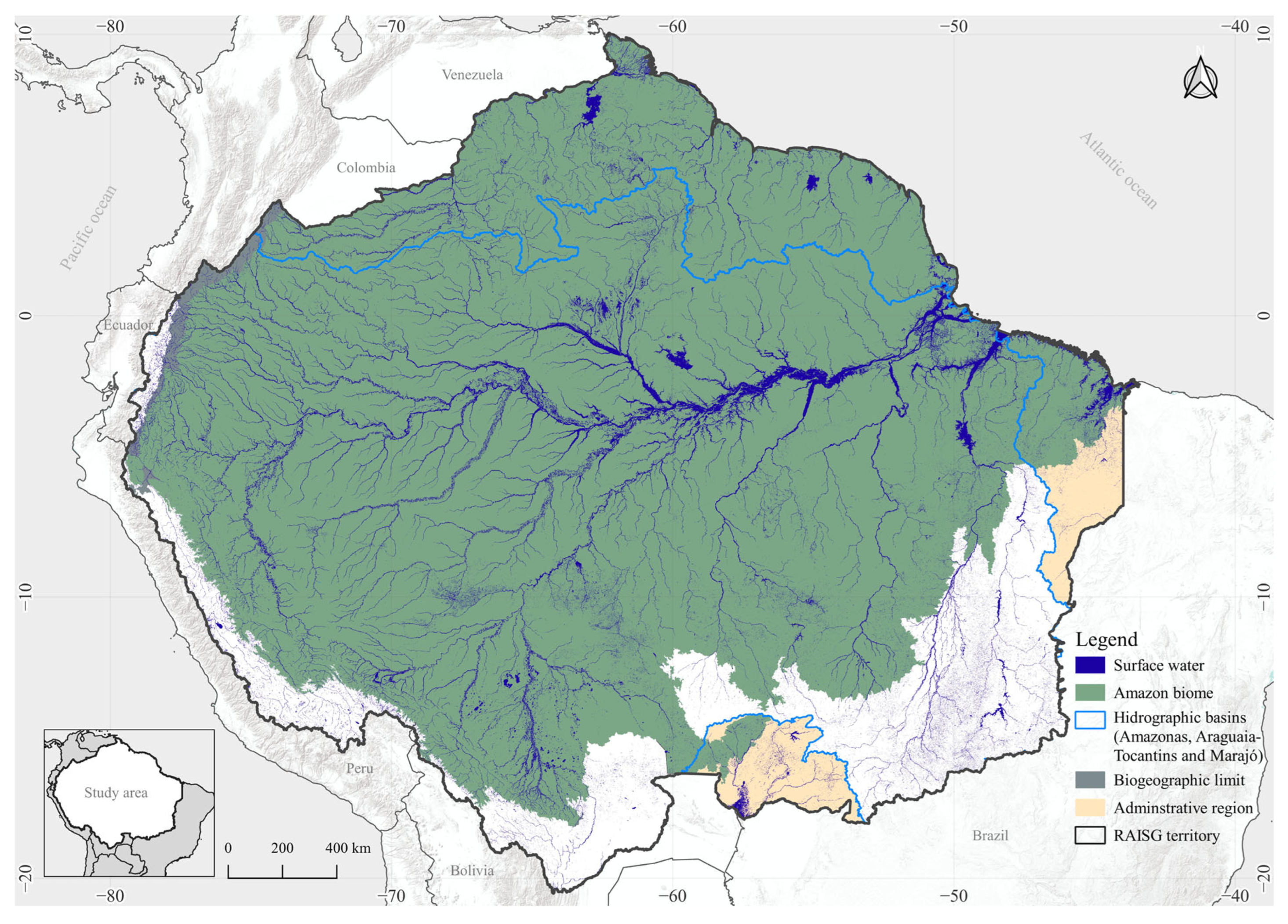
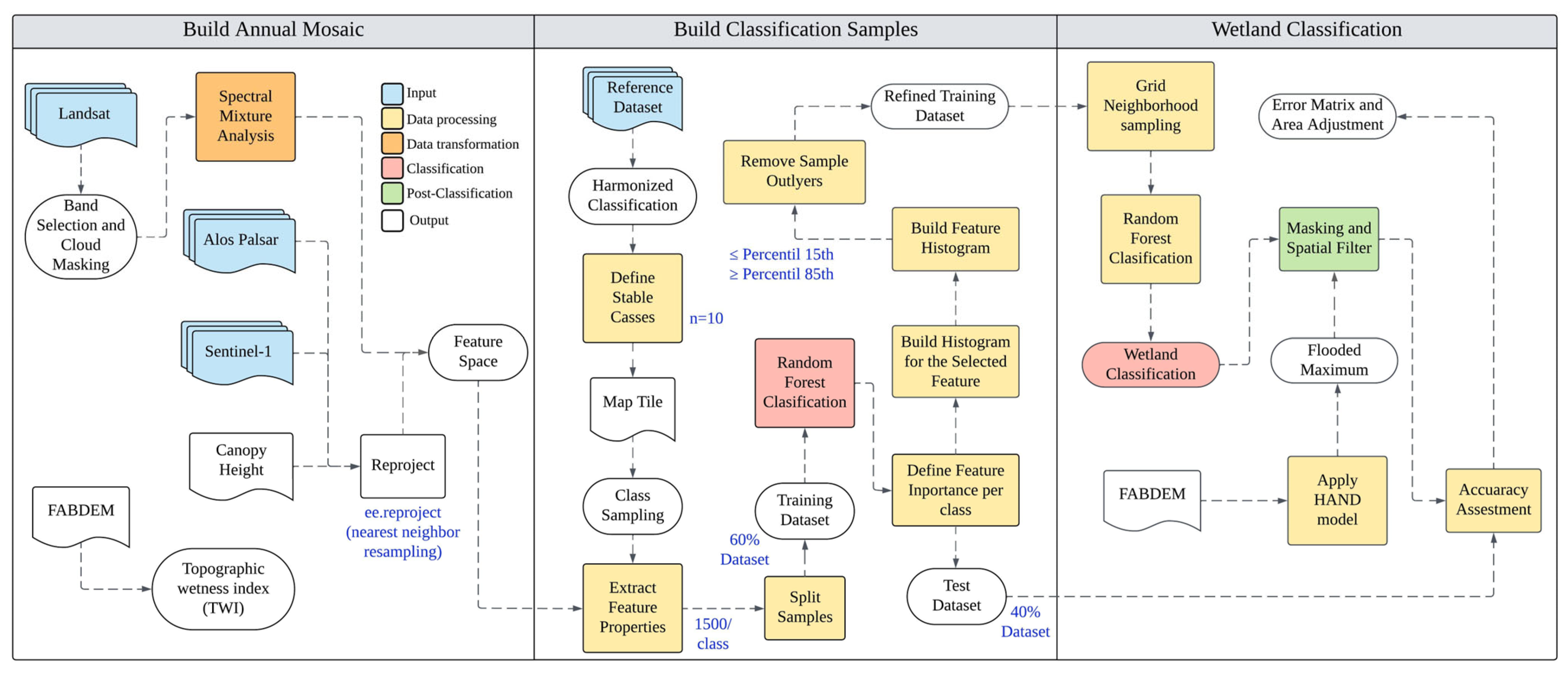
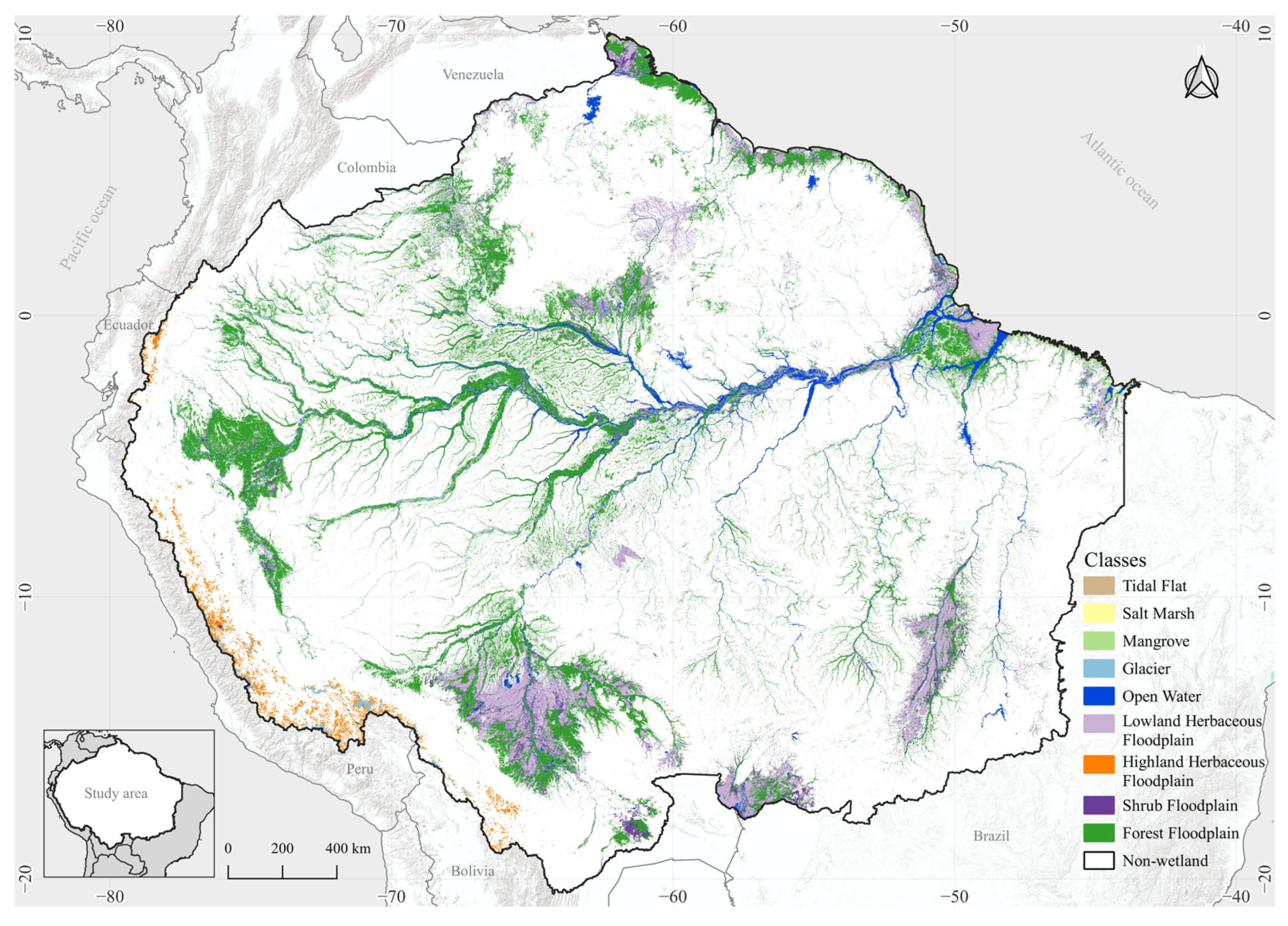


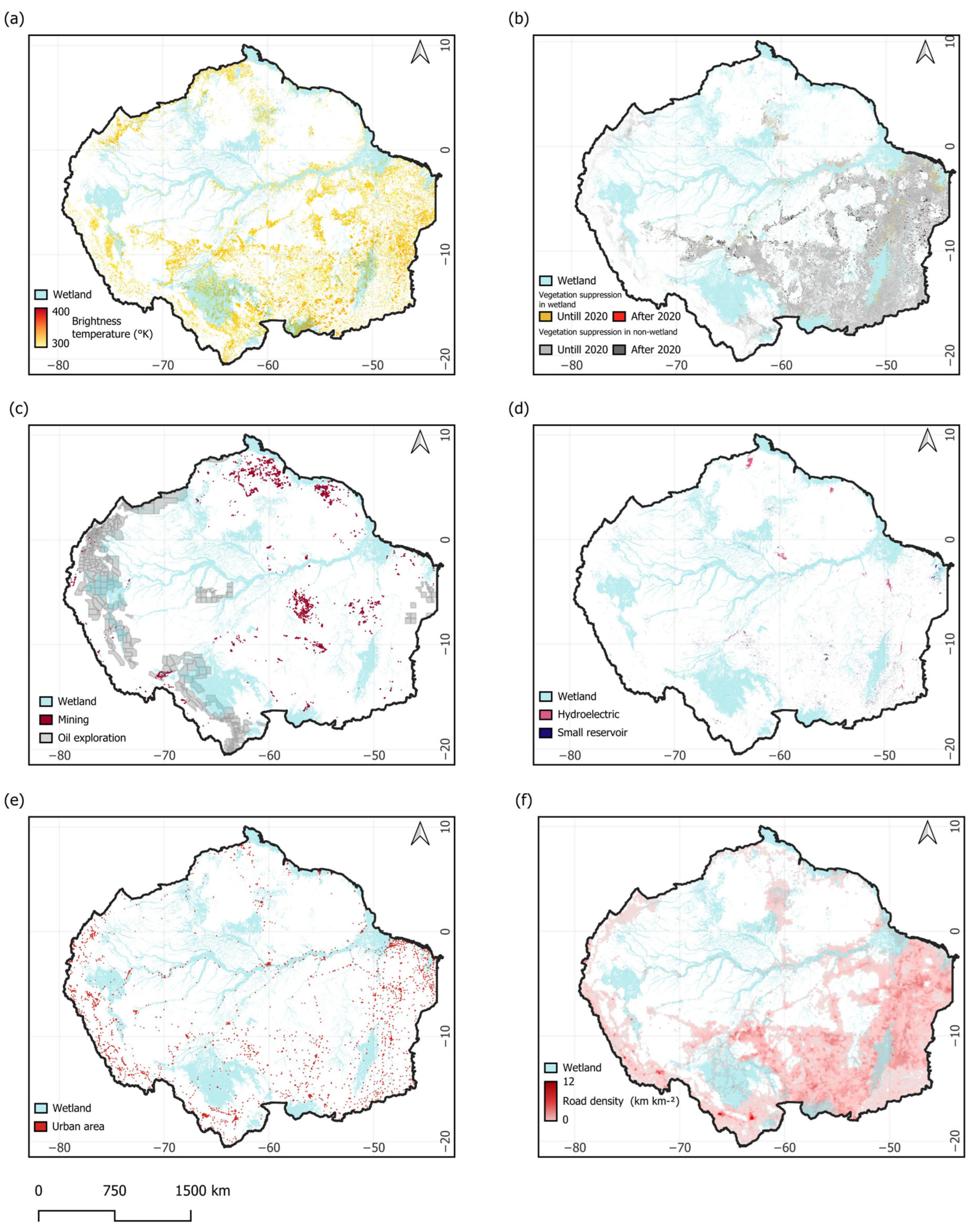
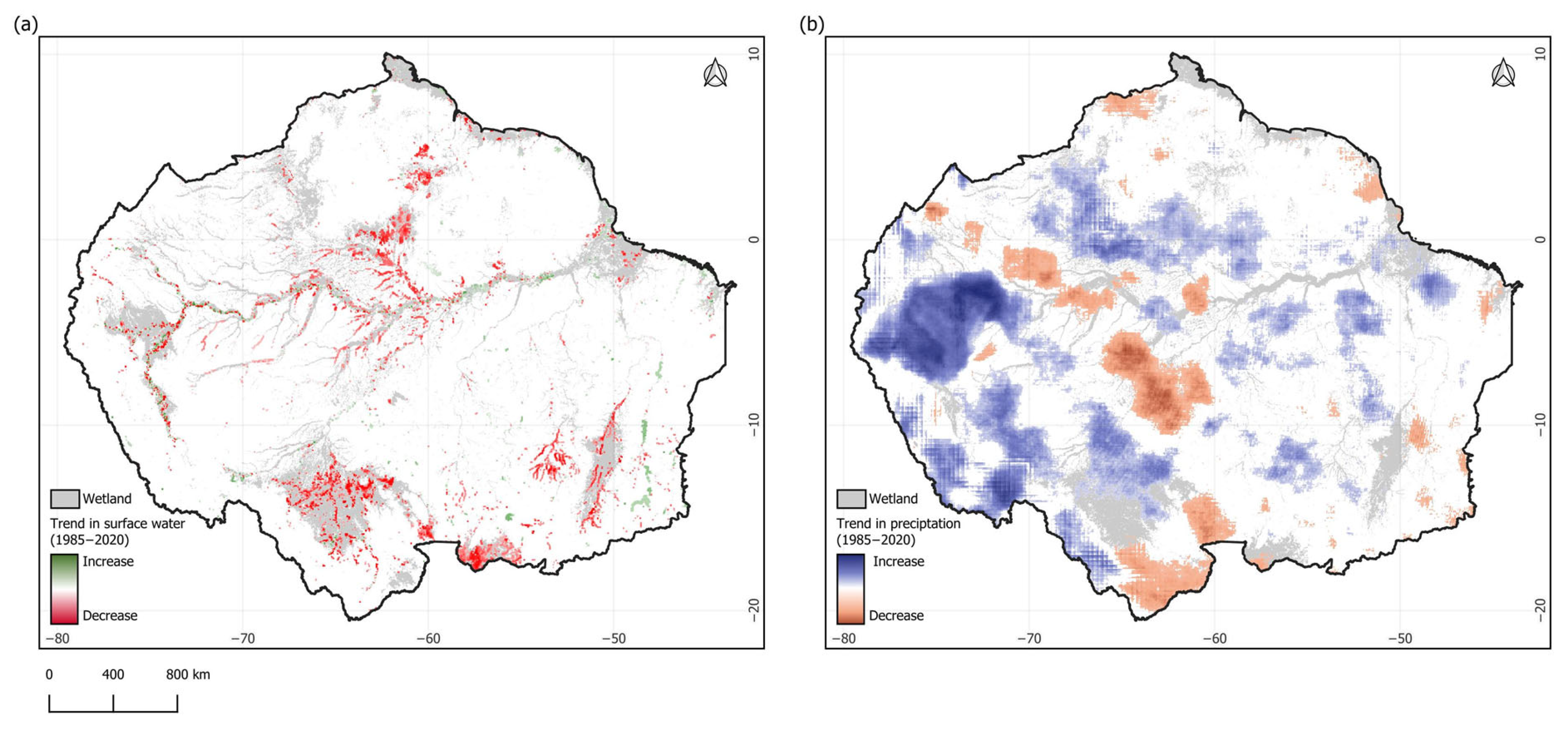
| Category | Wetland Class | Dataset | Spatial Resolution | Temporal Coverage | Accuracy | Coverage | Reference |
|---|---|---|---|---|---|---|---|
| Coastal | Mangrove | Global Mangrove Watch | 30 m | 2020 | OA = 87.4% | Global | [36] |
| UA = 86.2% | |||||||
| PA = 88.6% | |||||||
| ESA | 10 m | 2020–2021 | OA = 77.9% | Global | [37] | ||
| SBTN WRI | 30 m | 2020 | OA = 91.2% | Global | [38] | ||
| GLW-FCS30 | 30 m | 2020 | UA = 95.7% | Global | [39] | ||
| Salt Marsh | GLW-FCS30 | 30 m | 2020 | UA = 88.24% | Global | [39] | |
| Tidal Flat | Global Maps of Tidal Flats | 30 m | 1984–2020 | OA = 82.2% | Global | [40] | |
| GLW-FCS30 | 30 m | 2020 | UA = 94.81% | Global | [39] | ||
| Global Tidal Marsh Distribution | 10 m | 2020 | OA = 85.0% | Global | [41] | ||
| Inland | Open Water | MapBiomas Water | 30 m | 1985–2024 | OA = 92.0% | Regional | [42] |
| Global Surface Water (GSW) | 30 m | 2020 | PA = 95.0% | Global | [43] | ||
| UA = 99.0% | |||||||
| Highland Herbaceous Floodplain (>2600 masl) | Amazon Wetland LBA | 100 m | 2015 | OA = 86.2% | Regional | [44] | |
| SBTN WRI | 30 m | 2020 | OA = 91.2% | Global | [38] | ||
| ESA | 10 m | 2020 | OA = 77.9% | Global | [37] | ||
| GLAD LULC | 30 m | 2020 | OA = 85.0% | Global | [45] | ||
| Lowland Herbaceous Floodplain (<2600 masl) | ESA | 10 m | 2020 | OA = 77.9% | Global | [37] | |
| SBTN WRI | 30 m | 2020 | OA = 91.2% | Global | [38] | ||
| GLAD LULC | 30 m | 2020 | OA = 85.0% | Global | [45] | ||
| Shrub Floodplain | Amazon Wetland LBA | 100 m | 2015 | OA = 86.2% | Regional | [44] | |
| GLAD LULC | 30 m | 2020 | OA = 85.0% OA = 85.0% | Global | [45] | ||
| Amazon Wetland LBA | 100 m | 2015 | OA = 86.2% | Regional | [44] | ||
| SBTN WRI | 30 m | 2020 | OA = 91.2% | Global | [38] | ||
| Glacier | MapBiomas | 30 m | 2020 | OA = 96.32% | Regional | [46] |
| Class Name (ID) | Class Description | Class Examples |
|---|---|---|
| Non-Wetland (0) | Areas that lack wetland characteristics, typically consisting of dry land or upland environments without significant hydrological influence. | Agriculture, upland pastures, non-inundated forests, herbaceous areas, urban zones, etc. |
| Tidal Flat (1) | Low-lying coastal areas periodically flooded by tides, typically composed of mud, sand, or silt, and commonly found in estuaries and deltas. | Mudflats and sandbanks. |
| Salt Marsh (2) | Coastal wetlands dominated by salt-tolerant vegetation, typically located in estuaries, behind barrier islands, or along sheltered coastlines, and influenced by tidal movements. | Salt flats, halophytic vegetation, and hypersaline tidal flat areas. |
| Mangrove (3) | Coastal wetlands featuring salt-tolerant trees and shrubs that thrive in intertidal zones, providing essential coastal protection and supporting biodiversity. | Mangrove vegetation. |
| Glacier (4) | Large masses of slow-moving ice form from snow accumulated over long periods of time typically found in high-altitude regions. | Ice fields and permanent snow. |
| Open Water (5) | Large bodies of water, such as lakes, rivers, and reservoirs, characterized by a lack of emergent vegetation. | Rivers, lakes, and reservoirs. |
| Lowland Herbaceous Floodplain (6) | Wetlands dominated by herbaceous vegetation typically found in low-lying areas below 2600 m and are subject to periodic or seasonal flooding. | Floodplain grasslands and wetland grasses. |
| Highland Herbaceous Floodplain (7) | Wetlands dominated by herbaceous vegetation, primarily found in plains above 2600 m, subject to permanent or seasonal flooding. | Flooded rocky grasslands, high-altitude wetland vegetation, and bofedales. |
| Shrub Floodplain (8) | Wetlands within floodplains dominated by shrub vegetation and periodically inundated by water. | Floodplain shrubs and secondary floodplain vegetation. |
| Forest Floodplain (10) | Wetland areas within floodplains, dominated by trees and seasonal or permanent flooding. | Seasonally or permanently flooded forests along the floodplain of the major rivers. |
Disclaimer/Publisher’s Note: The statements, opinions and data contained in all publications are solely those of the individual author(s) and contributor(s) and not of MDPI and/or the editor(s). MDPI and/or the editor(s) disclaim responsibility for any injury to people or property resulting from any ideas, methods, instructions or products referred to in the content. |
© 2025 by the authors. Licensee MDPI, Basel, Switzerland. This article is an open access article distributed under the terms and conditions of the Creative Commons Attribution (CC BY) license (https://creativecommons.org/licenses/by/4.0/).
Share and Cite
Souza, C.M., Jr.; Ferreira, B.G.; Brandão, I.M.; Rios, S.; Aguilar-Brand, J.; Schirmbeck, J.; Valero, E.; Restrepo-Galvis, M.A.; Mollinedo-Veneros, E.; Terneus, E.; et al. Enhanced Amazon Wetland Map with Multi-Source Remote Sensing Data. Remote Sens. 2025, 17, 3644. https://doi.org/10.3390/rs17213644
Souza CM Jr., Ferreira BG, Brandão IM, Rios S, Aguilar-Brand J, Schirmbeck J, Valero E, Restrepo-Galvis MA, Mollinedo-Veneros E, Terneus E, et al. Enhanced Amazon Wetland Map with Multi-Source Remote Sensing Data. Remote Sensing. 2025; 17(21):3644. https://doi.org/10.3390/rs17213644
Chicago/Turabian StyleSouza, Carlos M., Jr., Bruno G. Ferreira, Ives Medeiros Brandão, Sandra Rios, John Aguilar-Brand, Juliano Schirmbeck, Emanuel Valero, Miguel A. Restrepo-Galvis, Eva Mollinedo-Veneros, Esteban Terneus, and et al. 2025. "Enhanced Amazon Wetland Map with Multi-Source Remote Sensing Data" Remote Sensing 17, no. 21: 3644. https://doi.org/10.3390/rs17213644
APA StyleSouza, C. M., Jr., Ferreira, B. G., Brandão, I. M., Rios, S., Aguilar-Brand, J., Schirmbeck, J., Valero, E., Restrepo-Galvis, M. A., Mollinedo-Veneros, E., Terneus, E., Rivero, N., Schirmbeck, L. W., Oliveira-Miranda, M. A., Augusto, C. C., Gonzales, J. E. V., Espinosa, J., Amilibia, J. C., Bentos, T. V., Silva, S. R., ... Wiederhecker, H. C. (2025). Enhanced Amazon Wetland Map with Multi-Source Remote Sensing Data. Remote Sensing, 17(21), 3644. https://doi.org/10.3390/rs17213644









